I always wanted to know more ... read
introduction
2 7 Y E A R S O
F I B M R I S C
1965 IBM ACS
In the 1960's IBM was behind in the scientific area and wanted
to design an advanced machine better than the CDC 6800, later called the
CDC 7600.
The idea for the ACS (IBM Advanced Computing Systems) design
started in 1965 with John Cocke's vision of a scientific supercomputer.
This was several years earlier than the RISC work at Berkeley and Stanford
Universities. The ACS project (which evolved from "Project Y", that
started late 1963) was cancelled in 1968.
Many of the innovative
CPU organization techniques pioneered in ACS were used in the IBM
RS/6000.
After ACS, John Cocke carried this understanding of compilers
and instruction sets with him to the IBM 801 project. John also greatly
influenced the IBM Cheetah and America projects, which were the
predecessors to the RS/6000.
Links:
A Secret 1960's
Supercomputer Project
IBM’s
ACS-1 Machine
Technical
Description of IBM ACS Project |
|
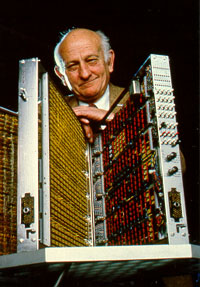 |
The A.M. Turing
Award
1987: John
Cocke for significant contributions in the design and theory of
compilers, the architecture of large systems and the development of
reduced instruction set computers (RISC); for discovering and
systematizing many fundamental transformations now used in
optimizing compilers including reduction of operator strength,
elimination of common subexpressions, register allocation, constant
propagation, and dead code
elimination. |
|
1974 the 801
IBM Reduced Instruction Set
Computer (RISC)
technology originated in 1974 in a project at the Thomas J. Watson Research
Center to design a large telephone-switching network. The computer needed was
named the 801 (after Building 801, where the research was taking
place). The goal of the 801 was to execute one
instruction per cycle. The experimental 801 was never build, but the design, mostly
developed by IBM researcher John Cocke, seemed to be an good basis for a
general-purpose, high-performance miniprocessor.
Links:
The evolution of
RISC technology at IBM (PDF)
1985
America
Based on the experimental
design of the 801 and ACS ideas the development laboratory in Austin completed a
first prototype, where it evolved into the superscalar (Instructions are handled
paralel) RISC System/6000 (RS/6000) processor that was introduced into the
market in 1990. Development work had been done under code name "America" for the
RISC chip research, and "RIOS" for systems using the America
technology.
1986 RT
PC
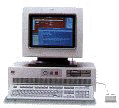 The IBM
RT PC is IBM's first RISC based UNIX (Advanced Interactive Executive [AIX])
computer with 32 bits ROMP processor (without floating point capability ...)
that was first announced by IBM in January 1986. The IBM RT has had a varied
life from its initial announcement. The RT was considered as "not enough power,
too high a price, and too late" and thought to be part of IBM's Personal
Computer line ... (hence RT PC, later renamed to RT).
The IBM
RT PC is IBM's first RISC based UNIX (Advanced Interactive Executive [AIX])
computer with 32 bits ROMP processor (without floating point capability ...)
that was first announced by IBM in January 1986. The IBM RT has had a varied
life from its initial announcement. The RT was considered as "not enough power,
too high a price, and too late" and thought to be part of IBM's Personal
Computer line ... (hence RT PC, later renamed to RT).
Links:
6150 RT PC Models 020, 025, and A25 IBM 6151 RT PC model
010
FAQ for AIX V2.2.1 on
IBM RT systems 1 2 3 4
1986 Advanced Interactive
Executive
AIX for the RT PC is announced.
The RT used the Virtual Resource Manager (VRM) that provided a virtual machine
environment for the kernel, allowing more than one operating system to execute.
AIX was based on INTERACTIVE Systems Corporation's IN/ix (the first commercial
Unix).
Links:
IBM
RT Personal Computer System Overview
The
IBM RT PC Advanced Interactive Executive (AIX) Operating System
RT PC AIX and Virtual Resource Manager
RT
PC AIX Version 2.1
1987 AIX (PS/2)
IBM will provide the PS/2 AIX Operating System as a subset of the
multiuser, multitasking, virtual memory AIX operating system currently available
on the IBM RT PC.
Links:
PS/2 AIX Statement of Direction
Availability of PS/2 AIX delayed ...
1990 POWER
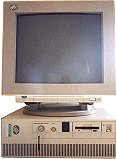 Februari 1990 IBM announces its new
RISC-based computer line, the RISC System/6000 (later named RS/6000, nowadays
eServer pSeries), running AIX Version 3. The architecture of the systems is
given the name POWER (now commonly referred to as POWER1), standing for
Performance Optimization With Enhanced RISC. They where based on a multiple chip
implementation of the 32-bit POWER architecture. The models introduced included
an 8 KB instruction cache (I-cache) and either a 32 KB or 64 KB data cache
(D-cache). They had a single floating-point unit capable of issuing one compound
floating-point multiply-add (FMA) operation each cycle, with a latency of only
two cycles and optimized 3-D
graphics capabilities.
Februari 1990 IBM announces its new
RISC-based computer line, the RISC System/6000 (later named RS/6000, nowadays
eServer pSeries), running AIX Version 3. The architecture of the systems is
given the name POWER (now commonly referred to as POWER1), standing for
Performance Optimization With Enhanced RISC. They where based on a multiple chip
implementation of the 32-bit POWER architecture. The models introduced included
an 8 KB instruction cache (I-cache) and either a 32 KB or 64 KB data cache
(D-cache). They had a single floating-point unit capable of issuing one compound
floating-point multiply-add (FMA) operation each cycle, with a latency of only
two cycles and optimized 3-D
graphics capabilities.
The model 7013-540
(30 MHz) processed 30 million instructions per second. Its electronic logic
circuitry had up to 800,000 transistors per silicon chip. The maximum memory
size was 256 Mbytes and its internal disk storage capacity was 2.5
GBytes.
Links:
RISC
System/6000 POWERstation/POWERserver 320
RISC System/6000 POWERstations/POWERservers 520 AND
530
RISC System/6000 POWERserver 540
RISC System/6000 POWERstation 730
RISC System/6000 POWERserver 930
AIX Version
3
AIX Version 3 is
announced.
Links:
AIX
Version 3 (Februari, 1990)
Overview: IBM RISC System/6000 and related
announcements
1991
With the alliance of Apple and Motorola, IBM started a plan
for the future that would span a range from the small, battery-operated computer
to very large supercomputers and mainframes, resulting in the PowerPC family of
microprocessors, a single-chip implementation for RISC-based hardware and
software.
Links:
Understanding IBM pSeries Performance and
Sizing
1992
RSC
 January
of 1992, the model 7011-220
(33 MHz)
January
of 1992, the model 7011-220
(33 MHz)  ,
an entry-level desktop workstation, was announced, based on a single chip
implementation of the POWER architecture, usually referred to as RISC Single
Chip (RSC). I recall we used to say "the pizza box".
,
an entry-level desktop workstation, was announced, based on a single chip
implementation of the POWER architecture, usually referred to as RISC Single
Chip (RSC). I recall we used to say "the pizza box".
Links:
RISC System/6000 POWERstation/POWERserver 220, 22W AND
22G
AIX PS/2 Version 1.3
Announcement of AIX PS/2 Operating
System Version 1.3 for IBM PS/2.
Links:
AIX PS/2 Operating System V1.3 (September 1992)
Withdrawal: IBM AIX PS/2 Operating System 1.3 (December
1994)
1993 SP
 The IBM Scalable POWERparallel Systems (SP,
now commonly referred to as
SP1) offer a scalable platform for both
serial and parallel applications. Based on RISC System/6000 technology, the
basic component of the in Februari 1993 announced 9076
SP1 is a system frame containing eight to 16 RISC System/6000 processor
nodes (max. four frames, 64 nodes).
The IBM Scalable POWERparallel Systems (SP,
now commonly referred to as
SP1) offer a scalable platform for both
serial and parallel applications. Based on RISC System/6000 technology, the
basic component of the in Februari 1993 announced 9076
SP1 is a system frame containing eight to 16 RISC System/6000 processor
nodes (max. four frames, 64 nodes).
The SP implements Massively Parallel
Processing (MPP). All the processing nodes have their own resources (processors,
memory, disks and operating system): the shared nothing architecture.
Links:
AIX
Parallel Environment
SP
models 001, 002, 003, 004, A01, AND 101
More SP models
2001 SP
Overview
PowerPC
601
The RISC System/6000 model 7011-250
(66 MHz) workstation, the first to be based on the 32-bit PowerPC 601 processor,
was introduced in September 1993.
The 601 was the first processor
arising out of a partnership between IBM, Motorola, and Apple. From IBM, the
RISC Single Chip (RSC) microprocessor became the base design for 601. The
superscalar machine organization of the 601 was improved to achieve greater
performance and additional custom circuit design was applied to reduce the die
size and to allow higher frequency operation. The Motorola 88110 microprocessor
bus interface formed the basis of the development of the 601 bus
interface.
The 601 did not implement the full PowerPC instruction set (some
infrequently used instruction where excluded) and some new instructions and
features were added, such as support for symmetric multiprocessor (SMP) systems.
The 601 is capable of dispatching, executing, and completing up to 3
instructions per cycle. Instructions issue to multiple execution units (an
integer unit, a branch processing unit, and a floating-point unit), execute in
parallel, and can complete out of order.
An SMP has multiple processors that
have their own cache, the memory and devices are shared.
The 601 was a
bridge from POWER to the full PowerPC architecture, such as the 603, 604, and
604e.
Links:
POWERstation/POWERserver
250 Series
POWER2
 The model 7013-590
(66 MHz) was announced in September 1993 and was the first RS/6000 based on the
32-bit POWER2 architecture. The most significant improvement introduced with the
POWER2 architecture for scientific and technical applications is that the
floating-point unit (FPU) contains two 64-bit execution units, so that two
floating-point multiply-add instructions may be executed each cycle. A second
fixed-point execution unit is also provided. In addition, several new hardware
instructions were introduced with POWER2: quad-word storage instructions,
hardware square root instruction and floating-point to integer conversion
instructions.
The model 7013-590
(66 MHz) was announced in September 1993 and was the first RS/6000 based on the
32-bit POWER2 architecture. The most significant improvement introduced with the
POWER2 architecture for scientific and technical applications is that the
floating-point unit (FPU) contains two 64-bit execution units, so that two
floating-point multiply-add instructions may be executed each cycle. A second
fixed-point execution unit is also provided. In addition, several new hardware
instructions were introduced with POWER2: quad-word storage instructions,
hardware square root instruction and floating-point to integer conversion
instructions.
Initial models: 7013-58H
(55 MHz), 7013-590
(66 MHz), 7015-990
(71.5 MHz).
Links:
POWER2 and PowerPC
architecture
AIX Version
3.2.5
AIX V3.2.5 is announced: Maturity (stability,
quality).
Links:
AIX
Version 3.2.5 (September, 1993)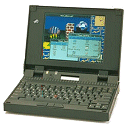
1994
Notebook
The RS/6000 7007-N40 (50 MHz)
notebook workstation (introduced in March) is the ideal portable companion for
mobile professionals who want to take AIX on the road. Based on the PowerPC
601.
Links:
7007-N40
IBM RS/6000 Model N40
SP2
The Scalable POWERparallel Systems 2
(SP2) was announced in April 1994. Based on IBM's RISC System/6000
microprocessor technology and running AIX/6000 (as it was named then), the SP2
could scale from two to 128 nodes (processing elements). Using a POWER2
processor and other options it performed twice the processing power of the SP1
system.
Links:
Scalable
POWERparallel Systems 9076 SP2 and Enhancements for SP1
Scalable Parallel
Computing
9076-xxx
SP Family
AIX Version
4.1
 AIX Version 4.1 is announced: Scalability (PowerPC support, 4-way SMP,
Client/Server pkg), new Standards compliance, Simplicity (graphical, fast
installation, Common Desktop Environment), HACMP Clustering.
AIX Version 4.1 is announced: Scalability (PowerPC support, 4-way SMP,
Client/Server pkg), new Standards compliance, Simplicity (graphical, fast
installation, Common Desktop Environment), HACMP Clustering.
Links:
AIX
Version 4.1 (July, 1994)
AIX
Version 4 Overview and Product Life Cycle Dates
AIX
Version 4.2 Overview and Product Life Cycle Dates
AIX
Version 4.3 Overview and Product Life Cycle Dates
1995 PowerPC
604
32-bit PowerPC 604 RISC
System/6000 microprocessor (120 MHz) upgrade announced for the RISC System/6000
model 7020-40P
(66 MHz).
Links:
Motorola/IBM PowerPC 604/604e
Windows NT PowerPC Edition
Announcement of Windows NT Workstation 3.51 for RS/6000 40P,
43P and with NT 4.0 (1996) other models.
Hmmm ... I'm not going to try
it on my 43P ...
Windows NT Workstation 3.51 Now Supports IBM Power
Series
Windows NT Support
for PowerPC Computers
 1996
POWER2 Super Chip
1996
POWER2 Super Chip
October 1996 the
RS/6000 model 7013-595
(135 MHz) was announced with the new 32-bit POWER2 Super Chip (also known as
P2SC). The P2SC is a single chip implementation of the POWER2 eight-chip
architecture, containing 15 million transistors on a single chip using
high-density CMOS-6S technology. It powered the wide and thin nodes in SP
systems.
Links:
SP
POWER2 Super Chip Nodes
RS/6000
In October (?) IBM renames RISC System/6000: RS/6000.

PowerPC 603e
October 1996, announcement of the portable workstation RS/6000
model 860 (166 MHz) - notebook - using the 32-bit PowerPC 603e
processor.
PowerPC 604e
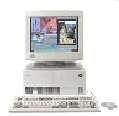 The 43P
models 140 and 240 with 32-bit PowerPC 604e RS/6000
microprocessor (166 MHz) are announced. The 604e is a superscalar processor
capable of issuing four instructions simultaneously. As many as seven
instructions can finish execution in parallel.
The 43P
models 140 and 240 with 32-bit PowerPC 604e RS/6000
microprocessor (166 MHz) are announced. The 604e is a superscalar processor
capable of issuing four instructions simultaneously. As many as seven
instructions can finish execution in parallel.
Links:
PowerPC 604e Technical Library
Windows NT for the PowerPC
withdrawn
AIX Version
4.2
AIX Version 4.2 is announced:
High-end scalability ( 8-way SMP, >2GB memory), Standards: UNIX95
brand, RAS Enhancements, NFS V3.
Links:
AIX
Version 4.2 (April 23)
1997
RS64
 The
RS64 (also known as Apache) is the first 64-bit PowerPC RISC processor (October
1997). The RS64 is a superscalar processor optimized for commercial workloads.
The processor has separate 64 KB L1 cache for instructions and data and L2 cache
controllers. The L2 caches run at full processor speed. The RS64 contains a 16
byte interface to 2-way set associative 4MB L2 cache. The RS64 is also used in
the AS/400 (called A35). Predecessors of the A35, only running OS/400 are the
A10 (a.k.a. Cobra), the world's first 64-bit PowerPC microprocessor, and A25
(a.k.a. Muskie).
The
RS64 (also known as Apache) is the first 64-bit PowerPC RISC processor (October
1997). The RS64 is a superscalar processor optimized for commercial workloads.
The processor has separate 64 KB L1 cache for instructions and data and L2 cache
controllers. The L2 caches run at full processor speed. The RS64 contains a 16
byte interface to 2-way set associative 4MB L2 cache. The RS64 is also used in
the AS/400 (called A35). Predecessors of the A35, only running OS/400 are the
A10 (a.k.a. Cobra), the world's first 64-bit PowerPC microprocessor, and A25
(a.k.a. Muskie).
IBM brings 64-bit technology to the market introducing the
RS/6000 Enterprise Server model 7017-S70
(125 MHz, code named Raven), the first 12-way SMP system, and AIX Version
4.3.
Links:
RS/6000
Enterprise Server Model S70 Blazes the 64-Bit Trail
AIX Version
4.3
AIX Version 4.3 is announced:
Higher levels of scalability (24-way SMP, 96 GB memory), 32/64-bit API support,
UNIX98  Branding, Networking/Security (TCP/IP
V6, IPsec), Web System Management, AIX Workload Manager, Java JDT/JIT,
32-bit/64-bit application coexistence and concurrent execution (the kernel is
still 32 bits).
Branding, Networking/Security (TCP/IP
V6, IPsec), Web System Management, AIX Workload Manager, Java JDT/JIT,
32-bit/64-bit application coexistence and concurrent execution (the kernel is
still 32 bits).
Links:
AIX
Version 4.3 (October 1997)
AIX
Version 4.3.1 (April 1998)
AIX
Version 4.3.2 (October 1998)
1998 RS64
II
PowerPC RS64 II 64-bit RISC
microprocessor (also know as NorthStar) is the first in the Star series
processor family.
The in July 1998 announced RS64-II contains a dedicated 32
byte interface to a private 4-way set associative 8MB L2 cache. The processor
target operating frequency is 262 MHz. The 262 MHz cards contain four processors
per card. Up to three 4-way cards can be installed in a RS/6000 7017-S70
to create a 4-way, 8-way, or 12-way system.
Links:
New
Processors Enhance the IBM RS/6000 Model S70 Performance
POWER3
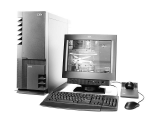 The
new 64-bit POWER3 processor, announced October 1998, unifies the POWER2
architecture (P2SC) with the PowerPC architecture, and was optimized for
technical applications.
The
new 64-bit POWER3 processor, announced October 1998, unifies the POWER2
architecture (P2SC) with the PowerPC architecture, and was optimized for
technical applications.
The SMP-capable POWER3 design allows for concurrent
operation of fixed-point instructions, load/store instructions, branch
instructions, and floating-point instructions. The POWER3 is capable of
executing up to four floating-point operations per cycle (two multiply-add
instructions). Integer performance has been significantly enhanced over the P2SC
with the addition of dedicated integer and load/store execution units. The chip
features eight execution units fed by a 6.4 gigabyte-per-second memory
subsystem. The core includes two high-bandwidth buses: a 128-bit 6XX
architecture bus to main memory and 256-bit bus to the L2 cache that runs at
processor speed. The POWER3 also has on-chip 64KB data cache and a 32KB
instruction cache.
IBM's first 64-bit symmetric multiprocessor (SMP)
workstation is the POWER3 based RS/6000 43P 7043-260
(200 MHz).
Links:
RS/6000
43P 7043 Model 260
The
POWER3 Microarchitecture
Overview of Recent
Supercomputers
History of
POWER processors
Characterization
of Web Server Workloads on Three Generations of IBM PowerPC
Microarchitectures (PDF)
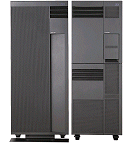 1999
RS64 III
1999
RS64 III
PowerPC RS64 III 64-bit RISC microprocessor (also known as Pulsar)
using copper technology. The RS64 III microprocessor powers the in September
1999 announced RS/6000 model 7017-S80
(450 MHz). The frequency of 450 MHz was accomplished by using IBM's new copper
technology (CMOS 7S). The RS64 III has 8 MB of Level 2 (L2) cache per processor.
The 6-way SMP can be expanded to a 24-way SMP and the system memory can be
expanded to 96 GB.
Links:
Custom circuit design as a driver of microprocessor
performance
AIX Version
4.3.3
AIX Version 4.3.3 is
announced.
links:
AIX
Version 4.3.x Overview and Product Life Cycle Dates
AIX
Version 4.3.3 UNIX Operating System ( September 1999)
2000 POWER3-II
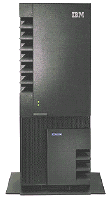 The 64-bit POWER3-II microprocessor design is based on IBM's
advanced CMOS 7S process, which is a
re-implementation of POWER3 using copper interconnects. The 64-bit POWER3-II microprocessor design is based on IBM's
advanced CMOS 7S process, which is a
re-implementation of POWER3 using copper interconnects.
New RS/6000
model 44P 7044-270
(375 MHz) using the 1-4 way SMP with POWER3-II copper-based
microprocessor.
The POWER3-III didn't surface, so POWER4 is the next
...
Links:
Power3-II
375/450 MHz Processors
RS/6000
44P 7044 Model 270
Why
copper?
Back to the Future: Copper Comes of Age |
|
| The use copper "wiring"
for integrated circuits in 1997 was a breakthrough in semiconductor
technology (smaller, faster, more powerful and less costly). The
first copper chip was a PowerPC for Apple iMac systems (September
1998). |
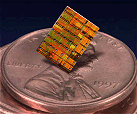 | |
eServer
pSeries
I n October IBM renames RS/6000:
eServer pSeries.
n October IBM renames RS/6000:
eServer pSeries.
Links:
IBM
introduces servers for the next generation of e-business
A Server
By Any Other Name
RS64 IV
PowerPC RS64 IV 64-bit RISC microprocessor (also known as
Sstar) using copper and SOI technology.
The in October 2000 announced pSeries
680 (600 MHz) a is 6- to 24-way 64-bit SMP server with up to 96GB of system
memory and 16MB L2 cache for each 600 MHz processor.
Links:
A multithreaded PowerPC processor for commercial
servers
AIX 5L Version
5.0
The initial release of AIX 5L was
not generally available. It was an Early Adopter Release for OEM's and
application developers to begin development of true 64-bit applications for a
64-bit AIX kernel.
 |
Silicon-on-insulator ( SOI)
technology improves performance over bulk CMOS technology by up to 35% and
reduces power requirements by up to 66%. SOI refers to placing a
thin layer of silicon on top of an insulator such as silicon oxide or
glass. The transistors would then be built on top of this thin layer of
SOI. The basic idea is that the SOI layer will reduce the capacitance (the
ability of a structure to store electrical charge) of the switch, so it
will operate faster. SOI protects the millions transistors on a chip with
a blanket of insulation, reducing harmful electrical effects that consume
energy and hinder performance. The first SOI/copper-based chip was shipped
in May 1999 (a PowerPC processor used in new AS/400
models). |
2001 POWER4
 The POWER4 "Gigaprocessor"
copper SOI 64-bit CMP microprocessor is based on all earlier
designs. The POWER4 "Gigaprocessor"
copper SOI 64-bit CMP microprocessor is based on all earlier
designs.
174-million-transistor POWER4 chip, with two 1.1/1.3 GHz
five-issue superscalar microprocessor cores, a triple-level cache
hierarchy, up to 256 GB memory, a 10-Gbyte/s main-memory interface, and a
45-Gbyte/s multiprocessor interface. The POWER4 is a CMP chip, which means
that it incorporates multiple processors on a single piece of
silicon.
AIX 4.3.3 is not supported on Power4.
Links:
IBM Journal of R
& D - Vol. 46, No. 1, 2002 - IBM POWER4 System
pSeries
690 System Handbook
p690 -- a
collection of white papers
p690 puts SPECjbb2000 leadership to rest
POWER4
System Microarchitecture
eSever
pSeries 690 Announcement
pSeries
690: Virtual Tour
IBM POWER4
microprocessor focuses on memory bandwidth (PDF)
IBM
Project Regatta
Logical Partitioning
(LPAR)
IBM Research
VLSI
Microprocessors
Linux
and AIX link up on IBM's biggest Unix server
Silicon-on-insulator
(SOI) and Copper
Technology
VARBusiness:
IBM’s p690 Server: Less Is More |
 The in October introduced 8-
to 32-way 64 bit SMP server 7040-681
(type model, which is not logical ...) pSeries
690 (code-named Regatta H) is the first server to use the POWER4
dual processor on a chip, and is the first model in the Regatta
family). Advanced MultiChip Module (MCM) packaging places up to
eight POWER4 processors onto a package that fits in the palm of a
hand (8.5x8.5 cm). The in October introduced 8-
to 32-way 64 bit SMP server 7040-681
(type model, which is not logical ...) pSeries
690 (code-named Regatta H) is the first server to use the POWER4
dual processor on a chip, and is the first model in the Regatta
family). Advanced MultiChip Module (MCM) packaging places up to
eight POWER4 processors onto a package that fits in the palm of a
hand (8.5x8.5 cm).
This new class of pSeries is the first UNIX
Datacenter system, utilizing mainframe-inspired self management
capabilities (eLiza).
Integrated static Logical Partitioning (LPAR)
support for up to 16 AIX 5L or Linux
partitions. | |
AIX 5L Version
5.1
 AIX 5L Version 5.1 is announced in April: Higher levels of scalability
(POWER4 Support, 32-way SMP, 256GB memory, full 64bit kernel and device drivers,
Logical Partitioning), Advanced RAS, Networking enhancements, Java 2 Version1.3,
Linux Application Support (Linux affinity). AIX 5.1 also supports 32-bit POWER
architecture and Intel Itanium (on a limited basis)
architecture.
AIX 5L Version 5.1 is announced in April: Higher levels of scalability
(POWER4 Support, 32-way SMP, 256GB memory, full 64bit kernel and device drivers,
Logical Partitioning), Advanced RAS, Networking enhancements, Java 2 Version1.3,
Linux Application Support (Linux affinity). AIX 5.1 also supports 32-bit POWER
architecture and Intel Itanium (on a limited basis)
architecture.
Links:
AIX 5L
AIX
5L Version 5.1
Monterey -
AIX on Itanium ?
Gartner assesses IBM's AIX 5L OS - Source: ZDNet
SP2 Overview
The RS/6000 SP system hosts dozens to hundreds of RISC processor
nodes facilitating parallel processing capability.
The basic SP
building block is the processor node. It consists of a POWER3 or PowerPC
Symmetric Multiprocessors (SMP), memory, Peripheral Component Interconnect
(PCI) expansion slots for Input/Output (I/O) and connectivity, and disk
devices. Nodes have either a Symmetric MultiProcessor (SMP) configuration
(using PCI) or a uniprocessor configuration (using MCA). The three types
of nodes (thin, wide, and high) may be mixed in a system and are housed in
short or tall system frames. Depending on the type of nodes used, an SP
tall frame can contain up to 16 nodes and an SP short frame can contain up
to 8 nodes. These frames can be interconnected to form a system with up to
128 nodes (512 by special order). Each node contains its own copy of the
AIX operating system.
Links:
RS/6000
SP and Clustered IBM eServer pSeries Systems Handbook
RS/6000
SP Processors
Advanced
Computer Technology Center (ACTC)
RS/6000 SP
Resource Center
RS/6000 SP Planning Volume 1, Hardware and Physical
Environment |
 The currently used 375 or
450 MHz POWER3 SMP nodes, are powered by the 64-bit 375 or 450 MHz
POWER3-II microprocessor. Earlier nodes used POWER1 (62 MHz), POWER2
(66/77 MHz), PowerPC 604 (112/200/332 MHz), P2SC (120/135/160
MHz) and POWER3 (200/222 MHz). The currently used 375 or
450 MHz POWER3 SMP nodes, are powered by the 64-bit 375 or 450 MHz
POWER3-II microprocessor. Earlier nodes used POWER1 (62 MHz), POWER2
(66/77 MHz), PowerPC 604 (112/200/332 MHz), P2SC (120/135/160
MHz) and POWER3 (200/222 MHz). |
|
2002
POWER4+
The POWER4+ processors (the
name POWER4-II circulated before the announcement) are announced in November
2002.
Source: ComputerWire, 21/01/2002 
Links:
IBM launches world's most powerful eight-way UNIX server and new
POWER4+ processor
AIX 5L Version
5.2
AIX 5L Version 5.2 is announced in
October:
Logical Partitioning (LPAR)
Support
-
Dynamic LPAR adds or removes processors,
adapters and memory without requiring a
reboot
-
Dynamic reconfigurations APIs permit
middleware and applications to automatically
adjust to system resource changes
-
Dynamic Capacity Upgrade on Demand
(CUoD) permits activation of additional
processors without requiring a reboot
-
Dynamic Processor Sparing (with CUoD)
permits substitution of failed processors with
spare, unlicensed processors
Scalability, Capacity and Resource
Management
- 16MB Large Pages speed transfer of data from
storage to memory on POWER4™ enterprise
systems
-
Memory Affinity and Scheduling Affinity
localize workloads internally by utilizing a
subset of processors that share uniform access to a subset of system
memory on POWER4 enterprise systems
-
JFS2 file size and file system support
increased to 16TB and adds native file system
snapshot support
-
Enablement added for VERITAS File
System
-
Workload Manager module is dynamic for
the management of resources within a
partitioned or single-image system. Enhanced to offer time-based resource policies and automatic administrator notification
when resource limits reached on "per class"
basis. New resources managed include number of
processes, logins and connect time
Networking Performance and
Technology
Reliability, Availability &
Serviceability (RAS)
- System UE-Gard detects errors that formerly would
result in a checkstop and instead just terminates the affected thread
- Adds automatic "lost I/O" detection and
recovery
- Dynamic Processor Deallocation default is set to
"enabled"
- Enhanced diagnostics that identify adapter cards
and storage devices by physical location
- Adds graphical trace log viewer
- Improved dump size estimation and scripting for
Automated Dump Analysis
- Added Multi-path I/O enablement for improved
connectivity and maintenance deferral
Security
- Adds Internet Key Exchange (IKE) support for DHCP
servers
- Adds Diffie-Hellman key agreement protocol
- Adds full Pluggable Authentication Module
(XSSO/PAM) support to help unify different
login mechanisms and reduce administrative overhead
- Adds authentication via x.509 certificates
- Adds IKE use of new, integrated random number
generator
- Kerberized r-commands are added to the security
services suite
- Adds enablement for Enterprise Identity Mapping
which is intended to associate the identity of
a user in one registry with the identity of the same user in another registry
System Management
- Adds centralized management of groups of AIX
servers via Distributed Command Execution
Manager application
- Adds capability to manage Linux® operating
system-based Intel® servers along with
AIX-based POWER servers
- System tuning parameters are centralized in SMIT
and the Web-based System Manager
- Adds Linux client for Web-based System
Manager
Interoperability
Base / Standards
- UNIX 98 Server certified
- Adds POSIX Asynchronous I/O support
- Adds DNS Bind Version 9 support for
networking
- Adds LDAP client support for RFC 2307, IBM
Directory and custom schema for
networking
- SNMP protocol upgraded to Version 3
- Common Host Bus Adapter (HBA) API added to improve
storage interoperability and management
- CIM management objects support added for web-based
system management
Tools for Performance, debugging and
transition
- AIX Toolbox for Linux Applications now includes
more than 380 applications
- Adds template-based AIX performance tuning via a
stanza based file that supports persistent
values and can be exported/imported to multiple servers
- Adds consolidated access to performance tuning
values in SMIT and Web-based System
Manager
- Adds xprofiler (GUI-based profiling tool) to the
base operating system
- Adds performance tools support for LPAR, Large
Pages and Memory Affinity
- Adds new thread analysis tools, curt and splat, to
the analysis tool suite
- Adds performance toolbox and iostat support for
ESS vpaths
- tprof tool is enhanced to provide multiple process
profiling, improved threads support and support
for emulation and alignment interrupts
- Kernel debugger is enhanced for crash and lldb
functions
- prtconf is enhanced to display processor
speed
- Adds 14 new commands for /proc and 31 additional
SVR4 commands
Links:
AIX Documentation Library
AIX Documentation (PDF)
All AIX Commands (fast!)
AIX V5.2 Release Notes
AIX 5L V5.2 Announcement
AIX Statement of
Direction (PDF)
Differences Guide AIX 5.2
Installation Guide AIX 5.2 (PDF)
Functional
Enh. Summary (PDF)
Functional list of AIX commands
Product Life Cycle Dates AIX 5.2
2003
POWER4+ Speeds
Up
In May 2003 the pSeries 655 and
pSeries 670/690 servers are upgraded with faster POWER4+ processors. For the
first time trial/temporary Capacity Upgrade on Demand (CUoD) is available in the
pSeries (add processors and/or memory on-the-fly).
The original POWER4 chips
were made using a 180 nanometer copper/SOI process. The new dual-core POWER4+
chip is made using a 130 nanometer copper/SOI process resulting in a higher
clock speed and a generated heath reduction. The new POWER4+ versions for the
pSeries 670/690 machines will run at 1.5GHz and 1.7GHz.
The higher
performance of the pSeries 670/690 is also due to the introduction of a new
optional RIO-2 (Remote I/O-2) backplane with support for 1GHz I/O busses that
support 133MHz PCI-X peripheral cards. This results in a aggregate I/O bandwidth
of 14 GB/sec for the pSeries 670 (was 6GB/sec) and 44 GB/sec for the pSeries 690
(was 16GB/sec). The new memory cards of the pSeries 670/690 are twice as dense
as prior memory cards. Faster L3-cache runs at 567 MHz. The pSeries 670 now
supports up to 256GB of main memory and the pSeries 690 up to 512GB. RIO-2 is
also available for the pSeries 650/655.
The 4-8 way pSeries 655 supports the
1.5GHz and the 1.7GHz POWER4+ chip and the existing 1.1GHz and the 1.3GHz POWER4
chip. The machine starts shipping by the end of May; upgrades start shipping end
of July.
The 4-8-16 way pSeries 670 only supports the POWER4+ chip
running at 1.5GHz and the existing 1.1GHz POWER4 chip.
The 8-16-32 way
pSeries 690 supports the 1.5GHz and the 1.7GHz POWER4+ chip and the existing
1.1GHz and the 1.3GHz POWER4 chip. The pSeries 670/690 starts shipping by the
end of May; upgrades start shipping in August.
DLPAR has been improved to
support 4 partitions on the pSeries 650/655 (was 2), 16 on the pSeries 670 (was
4) and 32 on the pSeries 690.
Links:
pSeries Announcement Brief (PDF)
IBM introduces new high-end eServer systems fueled by POWER4+
processors
p690 Description
p670 Description
p655 Description
IBM pSeries and IBM RS/6000 Performance Report (PDF)
pSeries 670/690 with faster POWER4+ and double maximum
Memory
pSeries 655 with faster POWER4+ and additional Memory
Options
pSeries 650 with CUoD and faster Performance using RIO-2
Adapters
Capacity Upgrade on Demand
PowerPC
970
The BladeCenter JS20 with PowerPC 970 (PPC 970), 1.6 GHz processors is
announced November 11,2003. IBM plans to support AIX in the third quarter of
2004.
The 64-bit PowerPC 970, a single-core
version of POWER4, can process 200 instructions at once at speeds of up to 2 GHz
and beyond while consuming just tens of watts of power. It is used in Apple
desktops, Apple Xserve servers, imaging applications, and -- increasingly -- in
networking applications.
Links:
BladeCenter JS20 — Fast 1.6 GHz SMP processor brings POWER
technology to the BladeCenter environment
2004 POWER5
POWER5-based servers, which will support 64-way SMP and up to
512GB of main memory.
POWER5 (code-named Squadron) and POWER6 processors are planned
to have an ability called "Fast Path", that takes over tasks that software
currently handles more slowly. The acceleration feature will speed up several
communication tasks, including the TCP/IP processing used to read and write data
on the Internet, and the Message Passing Interface (MPI), used to harness
clusters of computers into a collective supercomputer. And the chip will
accelerate virtual memory subsystem, a frequently used operating system feature
that manages how higher-speed regular memory can be expanded by using slower but
bigger hard drives.
POWER5, which will be built initially with 130-nanometer
(0.13 micron) features, also will feature "simultaneous multithreading," a
feature that allows a single chip to act as two.
IBM plans to use POWER5 in
"blade" servers as well, super-thin servers stacked densely like books in a
bookshelf. POWER4 produces 125 watts of power, but a blade processor is
constrained to about 25 to 40 watts.
"Partitioning," the ability to split a
single big server into several smaller ones, will improve. POWER4 permits a
partition that's the size of a single processor, but POWER5 will allow hundreds
of partitions.
Ravi Arimilli (chief technology officer for IBM's Power line)
stated in a recent interview that IBM's coming POWER5 processor was "95 to 97
percent" of the way toward a mainframe processor.
Source: eWeek, May 19, 2003

Source: CNET, 17/02/03 
Source: The Register, 17/12/2002 
Source: ComputerWire, 7/03/2002 
Source: CNET, 25/04/2002 
AIX 5L Version
5.3
AIX 5L Version 5.3 is expected
somewhere around August 2004.
Main features: sub-processor DLPARs (10 LPARs
per processor), virtual IO, intra-partition virtual ethernet, and shrink
filesystem.
2005
2006 POWER6
Photos: Courtesy of International Business
Machines Corporation. Unauthorized use not
permitted.

 The
The  Februari 1990 IBM announces its new
RISC-based computer line, the RISC System/6000 (later named RS/6000, nowadays
eServer pSeries), running AIX Version 3. The architecture of the systems is
given the name POWER (now commonly referred to as POWER1), standing for
Performance Optimization With Enhanced RISC. They where based on a multiple chip
implementation of the 32-bit POWER architecture. The models introduced included
an 8 KB instruction cache (I-cache) and either a 32 KB or 64 KB data cache
(D-cache). They had a single floating-point unit capable of issuing one compound
floating-point multiply-add (FMA) operation each cycle, with a latency of only
two cycles and optimized 3-D
graphics capabilities.
Februari 1990 IBM announces its new
RISC-based computer line, the RISC System/6000 (later named RS/6000, nowadays
eServer pSeries), running AIX Version 3. The architecture of the systems is
given the name POWER (now commonly referred to as POWER1), standing for
Performance Optimization With Enhanced RISC. They where based on a multiple chip
implementation of the 32-bit POWER architecture. The models introduced included
an 8 KB instruction cache (I-cache) and either a 32 KB or 64 KB data cache
(D-cache). They had a single floating-point unit capable of issuing one compound
floating-point multiply-add (FMA) operation each cycle, with a latency of only
two cycles and optimized 3-D
graphics capabilities. The IBM Scalable POWERparallel Systems (SP,
now commonly referred to as
SP1) offer a scalable platform for both
serial and parallel applications. Based on RISC System/6000 technology, the
basic component of the in Februari 1993 announced
The IBM Scalable POWERparallel Systems (SP,
now commonly referred to as
SP1) offer a scalable platform for both
serial and parallel applications. Based on RISC System/6000 technology, the
basic component of the in Februari 1993 announced  The model
The model 
 AIX Version 4.1 is announced: Scalability (PowerPC support, 4-way SMP,
Client/Server pkg), new Standards compliance, Simplicity (graphical, fast
installation, Common Desktop Environment), HACMP Clustering.
AIX Version 4.1 is announced: Scalability (PowerPC support, 4-way SMP,
Client/Server pkg), new Standards compliance, Simplicity (graphical, fast
installation, Common Desktop Environment), HACMP Clustering.

 The
The  The
RS64 (also known as Apache) is the first 64-bit PowerPC RISC processor (October
1997). The RS64 is a superscalar processor optimized for commercial workloads.
The processor has separate 64 KB L1 cache for instructions and data and L2 cache
controllers. The L2 caches run at full processor speed. The RS64 contains a 16
byte interface to 2-way set associative 4MB L2 cache. The RS64 is also used in
the AS/400 (called A35). Predecessors of the A35, only running OS/400 are the
A10 (a.k.a. Cobra), the world's first 64-bit PowerPC microprocessor, and A25
(a.k.a. Muskie).
The
RS64 (also known as Apache) is the first 64-bit PowerPC RISC processor (October
1997). The RS64 is a superscalar processor optimized for commercial workloads.
The processor has separate 64 KB L1 cache for instructions and data and L2 cache
controllers. The L2 caches run at full processor speed. The RS64 contains a 16
byte interface to 2-way set associative 4MB L2 cache. The RS64 is also used in
the AS/400 (called A35). Predecessors of the A35, only running OS/400 are the
A10 (a.k.a. Cobra), the world's first 64-bit PowerPC microprocessor, and A25
(a.k.a. Muskie). Branding, Networking/Security (TCP/IP
V6, IPsec), Web System Management, AIX Workload Manager, Java JDT/JIT,
32-bit/64-bit application coexistence and concurrent execution (the kernel is
still 32 bits).
Branding, Networking/Security (TCP/IP
V6, IPsec), Web System Management, AIX Workload Manager, Java JDT/JIT,
32-bit/64-bit application coexistence and concurrent execution (the kernel is
still 32 bits). The
new 64-bit POWER3 processor, announced October 1998, unifies the POWER2
architecture (P2SC) with the PowerPC architecture, and was optimized for
technical applications.
The
new 64-bit POWER3 processor, announced October 1998, unifies the POWER2
architecture (P2SC) with the PowerPC architecture, and was optimized for
technical applications.
 The 64-bit POWER3-II microprocessor design is based on IBM's
advanced CMOS 7S process, which is a
re-implementation of POWER3 using copper interconnects.
The 64-bit POWER3-II microprocessor design is based on IBM's
advanced CMOS 7S process, which is a
re-implementation of POWER3 using copper interconnects.
 n October IBM renames RS/6000:
eServer pSeries.
n October IBM renames RS/6000:
eServer pSeries.
 The POWER4 "Gigaprocessor"
copper SOI 64-bit CMP microprocessor is based on all earlier
designs.
The POWER4 "Gigaprocessor"
copper SOI 64-bit CMP microprocessor is based on all earlier
designs.  The in October introduced 8-
to 32-way 64 bit SMP server
The in October introduced 8-
to 32-way 64 bit SMP server  The currently used 375 or
450 MHz POWER3 SMP nodes, are powered by the 64-bit 375 or 450 MHz
POWER3-II microprocessor. Earlier nodes used POWER1 (62 MHz), POWER2
(66/77 MHz), PowerPC 604 (112/200/332 MHz), P2SC (120/135/160
MHz) and POWER3 (200/222 MHz).
The currently used 375 or
450 MHz POWER3 SMP nodes, are powered by the 64-bit 375 or 450 MHz
POWER3-II microprocessor. Earlier nodes used POWER1 (62 MHz), POWER2
(66/77 MHz), PowerPC 604 (112/200/332 MHz), P2SC (120/135/160
MHz) and POWER3 (200/222 MHz).